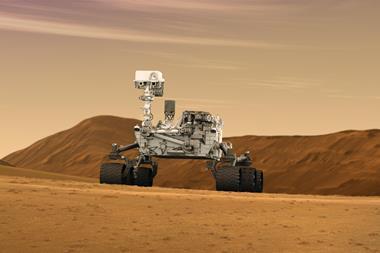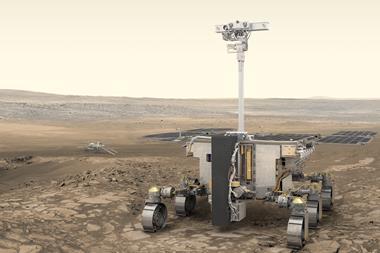Mars’ mysterious gullies could have been carved by liquid water produced when the planet was more heavily tilted on its axis, researchers in the US believe. During these periods, increased solar radiation at the planet’s poles would vaporise carbon dioxide, raising atmospheric pressure and allowing liquid water to form.1
Mars has ice at each pole and beneath the surface elsewhere, but is thought to be devoid of liquid water because its atmospheric pressure is below water’s triple point (612kPa). Under these conditions, ice sublimates rather than melting when warmed. But in 1999 observations by NASA’s Mars Global Surveyor mission revealed what appeared to be river gullies on steep slopes.

Some researchers have postulated these are actually formed by pressurised gas. ‘Scientists have made phenomenal observations of changes within these gullies that are well timed with when carbon dioxide should be going from an ice to a gas,’ says Jay Dickson of Caltech in California and Brown University in Rhode Island, ‘I’ve looked at these observations and it’s pretty clear to me that it’s loose sand and dust, and that’s not enough to carve these channels entirely.’ The hypothesis also fails to explain why no channels exist above 4500m from the surface.
Mars’ obliquity, or axial tilt, is more variable than Earth’s: it is presently 25° but it has been up to 35° in the past million years. In 2011, Roger Phillips at Colorado School of Mines and colleagues suggested that, in this case, increased solar radiation on the Southern polar ice cap would vaporise more carbon dioxide, increasing atmospheric pressure and allowing liquid water.2
Dickson and colleagues modelled Mars solar orbit of the Sun at 35° obliquity: ‘Mars gets above freezing quite frequently during the middle of the day,’ says Dickson; ‘We discovered this correlation between where the pressure is high enough and where these features appear that we think is unlikely to be a coincidence.’ The drop in pressure with altitude naturally explains the disappearance of the channels above 4500m. Dickson believes, therefore, that ‘650,000 years ago Mars was capable of having enough liquid water to carve these channels, which is good news if you’re looking for small amounts of life on the surface of Mars in the relatively recent past.’
Jack Mustard, also at Brown University but not involved in the research, believes it marks a significant contribution to solving a longstanding problem that has divided scientists into multiple camps. ‘The idea of it being liquid water has always been troubling because of the instability of liquid water on the surface,’ he says. He believes the present research puts a lot of previous speculation on a sound footing of quantitative modelling: ‘Pulling all those pieces together allows them to say in a declarative sense, “Yes, this is more than just speculation – we can make this statement.”’
Norbert Schorghofer at the Planetary Science Institute in Arizona is more cautious: ‘It’s an exciting correlation but what it really means remains to be seen,’ he says. Liquid water stability, he notes, would require the partial pressure of water vapour in the Martian atmosphere to rise above the triple point, and at present less than 0.1% of the total atmospheric pressure on Mars is due to water vapour: ‘That’s why it’s so difficult to have liquid water on Mars, and the authors don’t really explain it at all,’ he says; ‘It needs far more than just total pressure above the triple point and temperature above 273K for liquid water to form.’
Dickson agrees that future detailed studies will be needed to help ‘augment [this] global investigation’. ‘Our study addresses whether Mars was able to achieve the absolute minimum conditions for liquid water at gully locations, and we hope it inspires researchers to take an even closer look at this topic,’ he adds.
References
1. J L Dickson et al, Science, 2023, DOI: 10.1126/science.abk2464
2. R J Phillips et al, Science, 2011, DOI: 10.1126/science.1203091

















No comments yet